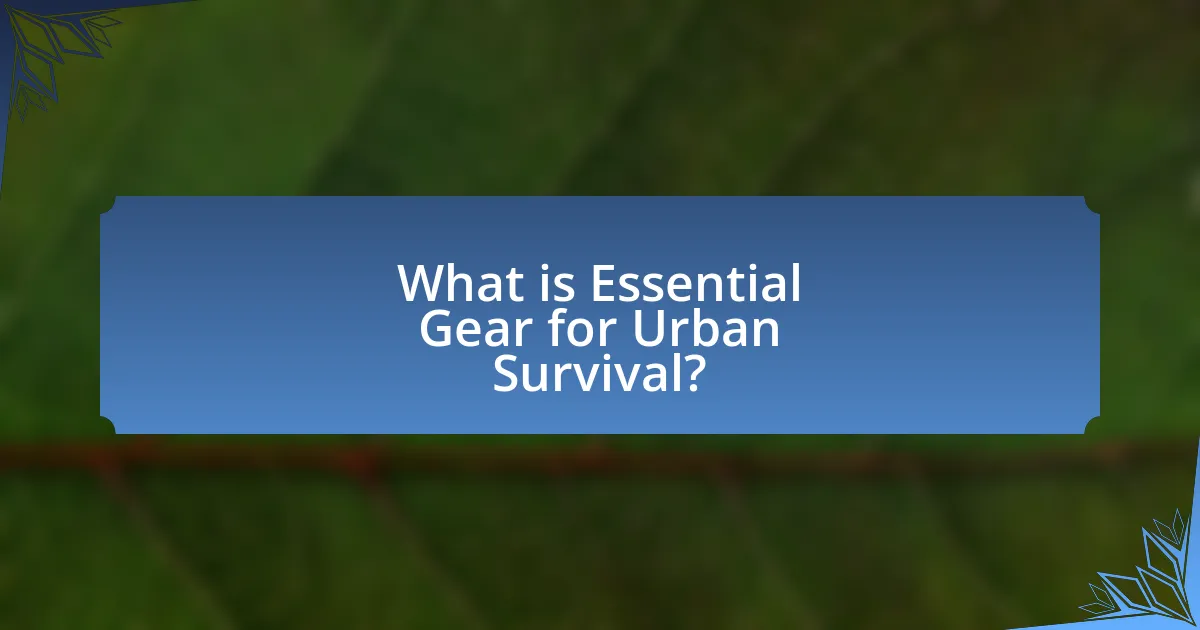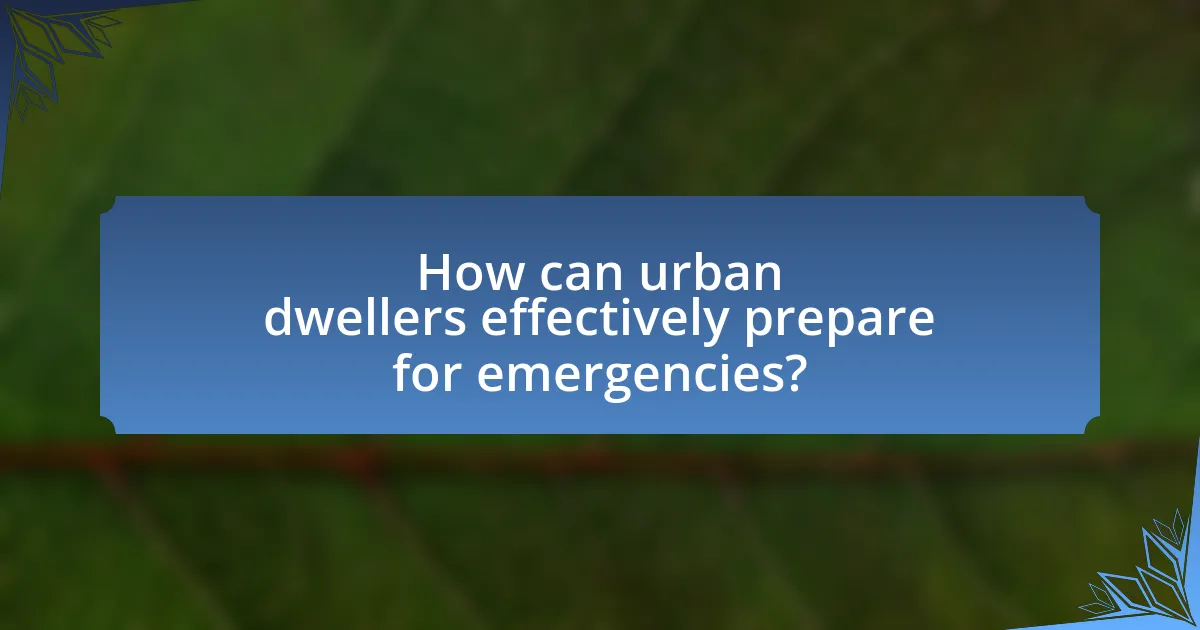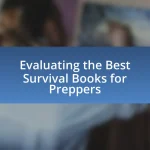Essential gear for urban survival is critical for city dwellers to effectively manage emergencies and unexpected situations. Key items include a multi-tool, first aid kit, water purification system, portable food supplies, flashlight, and reliable communication tools. The article outlines the importance of these items in addressing personal safety, health, and basic needs during crises, while also discussing the unique challenges faced by urban residents. Additionally, it emphasizes the role of preparedness gear in enhancing daily life, improving mobility, and providing peace of mind, along with best practices for maintaining this gear and staying informed about potential threats.

What is Essential Gear for Urban Survival?
Essential gear for urban survival includes a multi-tool, first aid kit, water purification system, portable food supplies, flashlight, and a reliable means of communication. These items are crucial for addressing emergencies, ensuring personal safety, and maintaining basic needs in urban environments. For instance, a multi-tool can assist in various tasks, while a first aid kit provides necessary medical supplies for injuries. Water purification systems ensure access to safe drinking water, which is vital during crises. Portable food supplies, such as energy bars, offer sustenance when regular food sources are unavailable. A flashlight is essential for visibility during power outages, and a reliable means of communication, like a charged mobile phone or a two-way radio, keeps individuals connected during emergencies.
Why is urban survival gear important for city dwellers?
Urban survival gear is important for city dwellers because it equips them to handle emergencies and unexpected situations effectively. In urban environments, risks such as natural disasters, civil unrest, or infrastructure failures can occur, necessitating preparedness. For instance, a study by the Federal Emergency Management Agency (FEMA) highlights that urban areas are particularly vulnerable to disasters, with over 70% of the U.S. population living in cities. Having essential gear, such as first aid kits, water purification systems, and multi-tools, enables city dwellers to respond quickly and efficiently, ensuring their safety and survival during crises.
What are the unique challenges faced by urban dwellers?
Urban dwellers face unique challenges such as high population density, limited access to green spaces, and increased cost of living. High population density often leads to overcrowding, which can exacerbate issues like noise pollution and stress. Limited access to green spaces affects mental health and community cohesion, as urban areas typically have fewer parks and recreational areas compared to rural settings. Additionally, the cost of living in cities is generally higher, making housing, transportation, and basic necessities more expensive, which can strain financial resources for residents. These challenges are supported by studies indicating that urban environments can contribute to higher levels of anxiety and depression among residents due to these stressors.
How can proper gear mitigate urban survival risks?
Proper gear can significantly mitigate urban survival risks by providing essential protection, enhancing mobility, and ensuring access to critical resources. For instance, items such as durable footwear can prevent injuries during emergencies, while multi-tools can facilitate various tasks, from self-defense to repairs. Additionally, gear like first aid kits and water purification systems can address health and hydration needs in crisis situations. Studies indicate that preparedness, including the use of appropriate gear, can reduce the impact of urban disasters, as evidenced by the Federal Emergency Management Agency’s findings on emergency readiness.
What types of gear are essential for urban survival?
Essential gear for urban survival includes a multi-tool, first aid kit, water purification system, portable food supplies, flashlight, and a reliable means of communication. A multi-tool provides various functions such as cutting, screwing, and opening cans, which are crucial in emergencies. A first aid kit is vital for treating injuries, as urban environments can pose risks of accidents. A water purification system ensures access to safe drinking water, which is critical during crises. Portable food supplies, such as energy bars or freeze-dried meals, offer sustenance when regular food sources are disrupted. A flashlight is necessary for visibility during power outages or in dark areas, while a reliable means of communication, like a charged mobile phone or a two-way radio, keeps individuals connected to emergency services and loved ones. These items collectively enhance preparedness for unexpected urban challenges.
What are the must-have items for personal safety?
Must-have items for personal safety include a personal alarm, pepper spray, a tactical flashlight, a first aid kit, and a whistle. A personal alarm can emit a loud sound to deter attackers, while pepper spray provides a means of self-defense. A tactical flashlight not only illuminates dark areas but can also be used to disorient an assailant. A first aid kit is essential for addressing injuries in emergencies, and a whistle can attract attention in distress situations. These items collectively enhance personal safety by providing tools for self-defense, emergency response, and signaling for help.
How do communication tools play a role in urban survival?
Communication tools are crucial for urban survival as they facilitate real-time information exchange, enabling individuals to respond effectively to emergencies. In urban environments, where risks such as natural disasters, civil unrest, or health crises can arise, having access to communication tools like smartphones, radios, and walkie-talkies allows residents to receive alerts, coordinate with others, and access vital resources. For instance, during Hurricane Sandy in 2012, effective communication through social media and mobile apps helped residents stay informed about evacuation routes and safety measures, demonstrating the importance of these tools in crisis situations.
How can urban survival gear enhance daily life?
Urban survival gear enhances daily life by providing essential tools and resources that improve safety, preparedness, and self-sufficiency in urban environments. For instance, items such as multi-tools, first aid kits, and portable water filters enable individuals to respond effectively to emergencies, whether they are natural disasters or urban crises. Research indicates that being prepared with survival gear can significantly reduce anxiety and increase confidence during unforeseen events, as individuals feel equipped to handle challenges. Furthermore, urban survival gear promotes a proactive mindset, encouraging city dwellers to develop skills and knowledge that contribute to overall resilience and adaptability in their daily lives.
What gear can improve mobility in a city environment?
Bicycles and electric scooters significantly improve mobility in a city environment. These modes of transportation allow individuals to navigate congested urban areas quickly and efficiently, reducing travel time compared to walking or using public transport. Studies indicate that cycling can increase commuting speed by up to 50% in dense city settings, while electric scooters provide a convenient option for short distances, often covering them faster than traditional walking. Additionally, both options contribute to reduced traffic congestion and lower carbon emissions, making them sustainable choices for urban mobility.
How does preparedness gear contribute to peace of mind?
Preparedness gear contributes to peace of mind by providing individuals with the tools and resources necessary to respond effectively to emergencies. When people possess items such as first aid kits, water purification systems, and emergency food supplies, they feel more secure in their ability to handle unexpected situations. Studies indicate that individuals who engage in preparedness activities report lower levels of anxiety and stress, as they believe they are better equipped to protect themselves and their families during crises. This sense of readiness fosters confidence and reduces uncertainty, ultimately enhancing overall mental well-being.
What are the key considerations when selecting urban survival gear?
Key considerations when selecting urban survival gear include functionality, portability, and adaptability. Functionality ensures that the gear serves multiple purposes, such as a multi-tool that can perform various tasks, which is crucial in urban environments where resources may be limited. Portability is essential because urban survival gear should be lightweight and easy to carry, allowing for quick mobility in emergencies. Adaptability is important as gear must be suitable for various scenarios, such as natural disasters or civil unrest, which can occur in urban settings. For instance, a compact emergency kit that includes first aid supplies, water purification tablets, and a flashlight can effectively address multiple survival needs.
How can one assess the quality of urban survival gear?
To assess the quality of urban survival gear, one should evaluate materials, functionality, and user reviews. High-quality urban survival gear is typically made from durable, weather-resistant materials such as nylon or polyester, which ensure longevity and reliability in various conditions. Functionality is crucial; gear should serve multiple purposes, such as a multi-tool that combines several tools into one compact design. User reviews provide insights into real-world performance, highlighting strengths and weaknesses based on actual experiences. For instance, a study by the Outdoor Industry Association indicates that 70% of consumers rely on reviews before purchasing outdoor gear, underscoring the importance of this assessment method.

What specific items should every city dweller consider?
Every city dweller should consider essential items such as a reliable public transportation pass, a portable phone charger, a reusable water bottle, and a compact umbrella. These items enhance mobility, ensure connectivity, promote hydration, and provide protection against unpredictable weather. For instance, a public transportation pass can save money and time, as urban areas often have extensive transit systems; in cities like New York, over 5 million rides are taken daily on the subway alone. A portable phone charger is crucial, as urban environments can lead to increased phone usage for navigation and communication, reducing battery life. A reusable water bottle supports sustainability and hydration, which is vital in bustling city life. Lastly, a compact umbrella is practical for sudden rain, which is common in many urban areas, ensuring that city dwellers remain prepared for changing weather conditions.
What personal safety items are crucial for urban survival?
Personal safety items crucial for urban survival include a personal alarm, pepper spray, a tactical flashlight, a first aid kit, and a multi-tool. A personal alarm can deter potential attackers by emitting a loud sound, while pepper spray provides a means of self-defense against aggressors. A tactical flashlight not only illuminates dark areas but can also be used to disorient an attacker. A first aid kit is essential for addressing injuries in emergencies, and a multi-tool offers various functions that can assist in different survival scenarios. These items collectively enhance personal safety and preparedness in urban environments.
How do self-defense tools vary in effectiveness?
Self-defense tools vary in effectiveness based on factors such as the type of tool, user proficiency, and situational context. For instance, pepper spray can incapacitate an attacker temporarily, but its effectiveness diminishes in windy conditions or if the user lacks proper aim. Similarly, personal alarms can attract attention and deter threats, but their impact relies on the proximity of bystanders. Studies indicate that tools like stun guns are effective in close-range encounters, yet their effectiveness can be influenced by the voltage and the user’s ability to deploy them quickly. Thus, the effectiveness of self-defense tools is not uniform and is contingent upon multiple variables.
What first aid supplies should be included in an urban survival kit?
An urban survival kit should include essential first aid supplies such as adhesive bandages, antiseptic wipes, gauze pads, medical tape, scissors, tweezers, a digital thermometer, and a first aid manual. These items are crucial for treating minor injuries and preventing infections in emergency situations. For instance, adhesive bandages and gauze pads are vital for covering wounds, while antiseptic wipes help clean them to reduce the risk of infection. The inclusion of scissors and tweezers facilitates the removal of splinters or cutting tape, ensuring effective treatment. A digital thermometer allows for monitoring body temperature, which is important in assessing health conditions. Having a first aid manual provides guidance on how to respond to various medical emergencies, enhancing the kit’s overall effectiveness.
What tools are essential for navigation and communication?
Essential tools for navigation and communication include a smartphone with GPS capabilities, a portable power bank, a map, and a two-way radio. Smartphones provide real-time navigation and communication through various apps, while GPS functionality ensures accurate location tracking. A portable power bank is crucial for keeping devices charged during emergencies. Physical maps serve as reliable backups when technology fails, and two-way radios facilitate communication in areas with poor cellular reception. These tools collectively enhance urban survival by ensuring individuals can navigate effectively and maintain communication in critical situations.
How can maps and compasses be useful in urban settings?
Maps and compasses are useful in urban settings by providing essential navigation tools that help individuals orient themselves and find their way in complex city environments. In densely populated areas, where GPS signals may be weak or unreliable, traditional maps offer a reliable alternative for understanding street layouts and landmarks. Compasses assist in determining direction, which is crucial when navigating unfamiliar neighborhoods or during emergencies. Studies show that reliance on maps and compasses can enhance spatial awareness and improve decision-making in urban navigation, making them vital for effective urban survival.
What role do portable chargers and power banks play in urban survival?
Portable chargers and power banks are crucial for urban survival as they ensure continuous access to power for essential devices like smartphones and GPS units. In urban environments, where communication and navigation are vital, having a reliable power source can facilitate emergency responses, maintain connectivity, and provide access to information. According to a survey by the Pew Research Center, 95% of Americans own a cellphone, highlighting the importance of keeping these devices charged, especially in emergencies or during power outages. Thus, portable chargers and power banks serve as essential tools for maintaining functionality and safety in urban settings.
What supplies are necessary for food and water security?
Food and water security requires essential supplies such as non-perishable food items, clean water storage containers, water purification systems, and agricultural tools. Non-perishable food items, including canned goods, dried grains, and legumes, provide a stable food source during emergencies. Clean water storage containers are crucial for maintaining a safe water supply, while water purification systems, such as filters or purification tablets, ensure that water is safe for consumption. Agricultural tools, including seeds and gardening equipment, enable individuals to grow their own food, enhancing self-sufficiency. These supplies collectively contribute to resilience against food and water shortages, as evidenced by studies showing that communities with adequate preparedness resources can better withstand crises.
How can water purification systems be integrated into urban survival gear?
Water purification systems can be integrated into urban survival gear by incorporating portable filtration devices, such as water bottles with built-in filters or compact filtration systems that can be easily carried. These systems allow urban dwellers to access safe drinking water from various sources, including tap water or natural bodies of water, which is crucial in emergency situations where clean water may be scarce. For instance, products like the LifeStraw or Sawyer Mini filter can remove bacteria and protozoa, making them effective for urban survival scenarios. Additionally, integrating chemical purification tablets or UV light purifiers can enhance the effectiveness of these systems, ensuring that urban survival gear is comprehensive and reliable for water safety.
What types of non-perishable food should be included in a survival kit?
A survival kit should include non-perishable foods such as canned goods, dried fruits, nuts, granola bars, rice, pasta, and freeze-dried meals. Canned goods provide essential nutrients and have a long shelf life, often lasting several years. Dried fruits and nuts offer high energy and are lightweight, making them ideal for emergency situations. Granola bars are convenient and easy to consume, while rice and pasta serve as staple carbohydrates that can be easily prepared. Freeze-dried meals are also beneficial as they are lightweight and require minimal preparation, making them suitable for survival scenarios. These food types ensure that individuals have access to necessary sustenance during emergencies.

How can urban dwellers effectively prepare for emergencies?
Urban dwellers can effectively prepare for emergencies by creating a comprehensive emergency plan and assembling essential supplies. An emergency plan should include communication strategies, evacuation routes, and designated meeting points for family members. Additionally, essential supplies such as a first aid kit, non-perishable food, water, flashlights, batteries, and a multi-tool should be readily available. According to the Federal Emergency Management Agency (FEMA), having a well-stocked emergency kit can significantly increase survival chances during disasters, as it ensures access to necessary resources when immediate help may not be available.
What strategies can enhance urban survival preparedness?
To enhance urban survival preparedness, individuals should focus on developing a comprehensive emergency plan, acquiring essential survival gear, and participating in community preparedness training. A well-defined emergency plan includes identifying escape routes, establishing communication protocols, and preparing for various scenarios such as natural disasters or civil unrest. Essential survival gear should consist of items like a first aid kit, water purification systems, non-perishable food supplies, and multi-tools, which are critical for sustaining life in emergencies. Community preparedness training, such as first aid courses and disaster response drills, fosters collaboration and resource sharing among residents, increasing overall resilience. According to the Federal Emergency Management Agency (FEMA), communities that engage in preparedness training are better equipped to respond effectively to crises, thereby reducing the impact of disasters on urban populations.
How can regular drills improve readiness for urban emergencies?
Regular drills enhance readiness for urban emergencies by ensuring that individuals and teams are familiar with emergency protocols and can execute them efficiently under pressure. These drills simulate real-life scenarios, allowing participants to practice critical skills such as evacuation, communication, and resource management. Research indicates that regular training can improve response times by up to 30%, as individuals become more adept at recognizing and reacting to emergency situations. Furthermore, consistent practice fosters teamwork and coordination, which are essential during crises, ultimately leading to better outcomes in actual emergencies.
What community resources can support urban survival efforts?
Community resources that can support urban survival efforts include local food banks, community gardens, emergency shelters, and neighborhood watch programs. Food banks provide essential nutrition to individuals and families in need, while community gardens promote self-sufficiency and access to fresh produce. Emergency shelters offer temporary housing during crises, and neighborhood watch programs enhance safety and security by fostering community vigilance. These resources are vital for enhancing resilience and preparedness in urban environments, especially during emergencies or economic hardships.
What are the best practices for maintaining urban survival gear?
The best practices for maintaining urban survival gear include regular inspection, proper cleaning, and appropriate storage. Regular inspection ensures that all items are functional and ready for use; for example, checking batteries in flashlights and testing water purification systems. Proper cleaning prevents deterioration; for instance, washing multi-tools and knives to remove rust and debris. Appropriate storage in a cool, dry place protects gear from environmental damage, such as moisture affecting electronics or food supplies. Following these practices enhances the longevity and reliability of urban survival gear, ensuring preparedness in emergencies.
How can urban dwellers stay informed about potential threats?
Urban dwellers can stay informed about potential threats by utilizing multiple information sources such as local news outlets, social media platforms, and community alert systems. Local news provides timely updates on crime, weather, and emergencies, while social media allows for real-time sharing of information among residents. Community alert systems, often managed by local governments, send notifications about threats like natural disasters or public safety issues directly to subscribers. According to a 2021 survey by the Pew Research Center, 64% of Americans receive news from social media, highlighting its role in disseminating information quickly.
What practical tips can help city dwellers optimize their urban survival gear?
City dwellers can optimize their urban survival gear by prioritizing multi-functional items, ensuring compactness, and regularly updating their supplies. Multi-functional items, such as a multi-tool or a tactical flashlight, reduce the need for multiple tools, saving space and weight. Compact gear, like a lightweight emergency blanket or a portable water filter, allows for easy transport and storage in urban environments. Regularly updating supplies, including food and medical kits, ensures that items remain usable and effective, as expiration dates can render them useless. These strategies enhance preparedness and adaptability in urban survival situations.


